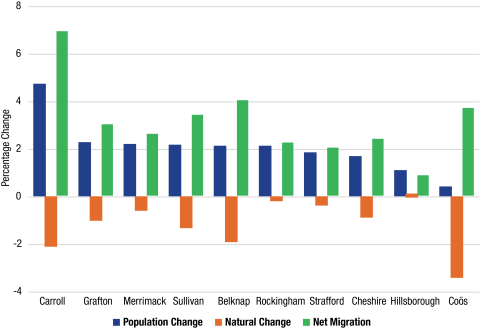Key Findings


New Hampshire’s population reached 1,402,054 on July 1, 2023, an increase of 24,500 residents (1.8 percent) since April 1, 2020, according to new Census Bureau estimates. The state continued to gain population last year, though the rate of increase diminished. New Hampshire gained 3,100 residents last year compared to 11,500 and 8,800 in the two preceding years, respectively. The state gained population even though it had 6,600 more deaths than births in the past three years because nearly 31,000 more people moved to the state than left it. Nearly 80 percent of these migrants came from within the United States, but the state also received a significant number of immigrants. Percentagewise, New Hampshire’s population gain since 2020 exceeded that of every state in the Northeast except Maine and was greater than the overall U.S. gain. However, it was smaller than population gains in many Southern and Western states.
All ten of New Hampshire’s counties gained population between 2020 and 2023, compared to 52 percent of all counties nationwide. However, the magnitude of the population increases varied from county to county (Figure 1). Carroll County had the largest percentage population gain, growing by 4.7 percent since 2020. Five other counties also had population gains exceeding the state total. Coös County had the smallest population gain (0.4 percent). Rockingham County had the largest numerical gain of 6,500.
Migration Fueled New Hampshire’s Population Gain
Such widespread population gains are surprising given that deaths exceeded births in nine of New Hampshire’s ten counties. Only Hillsborough County had more births than deaths (Figure 2). Natural losses were greatest in Coös, Carroll, and Belknap counties. Covid contributed to these widespread natural losses, but annual deaths already exceeded births in the state before the pandemic. Migration has long provided most of the state’s population gain, but in each of the last seven years it has produced the entire population gain. All ten counties gained migrants between April 2020 and July 2023. The largest migration gain (6.9 percent) was in Carroll County, which has long attracted recreational and amenity migrants, including many from large urban areas. This substantial migration gain in Carroll County offsets a significant natural loss to produce the state’s largest population gain. In northernmost Coös County, where deaths far exceeded births, migration was sufficient to produce a modest population gain. Even in Hillsborough County, where births exceeded deaths, migration produced nearly 90 percent of the population gain.
Figure 1. New Hampshire Counties Percentage Population Change, 2020 to 2023

Source: U.S. Census Bureau Population Estimates
Figure 2. Demographic Change in New Hampshire Counties, 2020 to 2023

Source: U.S. Census Bureau Population Estimates
As we have seen, migration fueled population gains in all ten New Hampshire counties between 2020 and 2023. However, the pace of growth slowed between July 2022 and July 2023. In the past year, population gains diminished in eight of the state’s ten counties. And in Hillsborough and Coös Counties, there were minimal population losses. Reduced migration to the state coupled with continued natural decrease caused the slower pace of population change.
These new Census data underscore the continuing importance of migration to the state’s demographic future. Such migration gains result both from attracting migrants to the state and retaining existing residents. This emphasizes the importance of developing policies that encourage current residents to remain and new migrants to come to New Hampshire, as well as policies that ensure New Hampshire communities are prepared to support these migrants.
Methods and Data
This analysis is based on Census Bureau Population Estimates for April 1, 2020, to June 30, 2023, released on March 14, 2024. The Bureau uses the best data and algorithms available at the time of release to generate the data, but they remain estimates and are subject to future revision.
About the Author

Kenneth M. Johnson is senior demographer at the Carsey School of Public Policy, professor of sociology at the University of New Hampshire, and an Andrew Carnegie Fellow. His research is supported by the NH Agricultural Experiment Station through joint funding from the USDA National Institute of Food and Agriculture (under Hatch-Multistate project W5001, award number 7003437) and the state of New Hampshire. The opinions are his and not those of the sponsoring organizations.